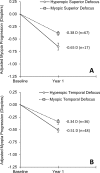Peripheral defocus and myopia progression in myopic children randomly assigned to wear single vision and progressive addition lenses
- PMID: 23838771
- PMCID: PMC3755539
- DOI: 10.1167/iovs.13-11904
Peripheral defocus and myopia progression in myopic children randomly assigned to wear single vision and progressive addition lenses
Abstract
Purpose: To determine the effect of progressive addition lenses (PALs) and single vision lenses (SVLs) on peripheral defocus in myopic children, and to compare the effect of myopic versus hyperopic peripheral defocus on foveal myopia progression.
Methods: Eighty-four myopic children aged 6 to 11 years with spherical equivalent (SE) cycloplegic autorefraction between -0.75 diopters (D) and -4.50 D were randomly assigned to wear SVLs or PALs. Aberrometry measurements of the eye and spectacles were made centrally, 30° nasally, temporally, and superiorly, and 20° inferiorly on the retina using a Complete Ophthalmic Analysis System for Vision Research (COAS-VR). The association between peripheral defocus and the 1-year change in central myopia was investigated.
Results: SVLs caused a hyperopic shift in peripheral defocus at all locations (all P ≤ 0.0003). PALs caused a myopic shift in peripheral defocus in three of four locations measured (all P ≤ 0.01) with the greatest shift superiorly due to the PAL addition (-1.04 ± 0.30 D). Superior retinal defocus when wearing either SVLs or PALs was associated with the 1-year change in central myopia. The adjusted 1-year change in central SE myopia was -0.38 D for children with absolute superior myopic defocus (n = 67) and -0.65 D for children with absolute superior hyperopic defocus (n = 17; difference = 0.27 D; P = 0.002).
Conclusions: PALs caused a myopic shift in peripheral defocus. Superior myopic defocus was associated with less central myopia progression. These data support the continued investigation of optical designs that result in peripheral myopic defocus as a potential way to slow myopia progression. (ClinicalTrials.gov number, NCT00335049.).
Keywords: children; myopia progression; peripheral defocus; progressive addition lenses; single vision lenses.
Figures



References
-
- Correction of Myopia Evaluation Trial 2 Study Group for the Pediatric Eye Disease Investigator Group Progressive-addition lenses versus single-vision lenses for slowing progression of myopia in children with high accommodative lag and near esophoria. Invest Ophthalmol Vis Sci. 2011; 52: 2749–2757 - PMC - PubMed
-
- Gwiazda J, Hyman L, Hussein M, et al. A randomized clinical trial of progressive addition lenses versus single vision lenses on the progression of myopia in children. Invest Ophthalmol Vis Sci. 2003; 44: 1492–1500 - PubMed
-
- Hasebe S, Ohtsuki H, Nonaka T, et al. Effect of progressive addition lenses on myopia progression in Japanese children: a prospective, randomized, double-masked, crossover trial. Invest Ophthalmol Vis Sci. 2008; 49: 2781–2789 - PubMed
-
- Yang Z, Lan W, Ge J, et al. The effectiveness of progressive addition lenses on the progression of myopia in Chinese children. Ophthalmic Physiol Opt. 2009; 29: 41–48 - PubMed
Publication types
MeSH terms
Associated data
Grants and funding
LinkOut - more resources
Full Text Sources
Other Literature Sources
Medical

